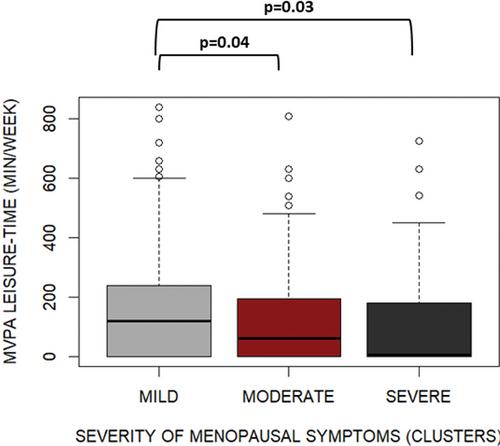Physical Activity and Sedentary Behavior in Middle-Aged Women: Is It Menopause Stages or Symptoms That Matter?
Abstract
Background and Aims
Menopause induces symptoms such as hot flashes, depression, and anxiety, which impair quality-of-life. Regular physical activity (PA) seems to be a favorable non-pharmacological approach to mitigate consequences of menopause. However, studies showed that middle-aged women reduce PA participation, possibly due to menopausal stage transition or symptoms. This study aimed to evaluate the association of menopausal stage and symptoms severity with PA and sedentary time in women.
Methods
An online study was conducted among pre-, peri-, and postmenopausal women. Menopausal symptoms were evaluated using Menopausal Rating Scale, Hospital Anxiety and Depression Questionnaire, Insomnia Severity Index, Hot Flash-Related Daily Interference Scale, and newly developed Anxiety and Depressive Interference Scales. Moderate-to-vigorous PA (MVPA) time (during work, transport, and leisure-time) and sedentary time were assessed using the Global Physical Activity Questionnaire. Clusters were created using scores from all questionnaires assessing symptoms. Nonparametric MANCOVA, Kruskal–Wallis test, and Dunn post hoc were used to compare MVPA and sedentary time between groups.
Results
A total of 462 women completed the questionnaire, and three clusters representing low, moderate, and severe symptoms were identified. No significant differences between menopausal stages for MVPA and sedentary time were found. However, a significant effect (p = 0.018) was found across clusters. Regarding PA domain only, leisure-time MVPA differed among clusters (p = 0.02). Women experiencing moderate-to-severe symptoms had lower levels of leisure-time MVPA compared to women with mild symptoms (p < 0.05).
Conclusions
These findings indicate that women experiencing moderate-to-severe symptoms are also likely to have lower levels of PA during leisure-time independent of their menopause stages.


 求助内容:
求助内容: 应助结果提醒方式:
应助结果提醒方式:


